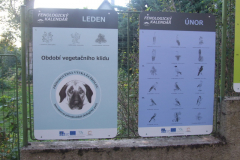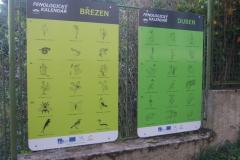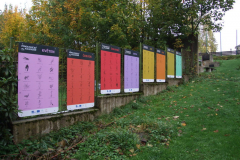OBSERVATION OF THE (NON-) REPEATABLE LIFE OF NATURE

Every year many phenomena repeat in nature. Trees are blooming and have fruits, new leaves grow on deciduous trees every spring to fall again in autumn, migratory birds come and go, etc. In this so-called phenological calendar you will find out what’s happening in the surrounding countryside in particular months of the year.
Source:
http://www.mergus.be/wp-content/uploads/2011/03/Kraanvogels-foto-Danny-Roobaert.jpg
Phenology
is a science dealing with the study of periodic plant and animal life cycle events – phenological plant and animal life phases.
Sciences dealing with phenology are as follows:
• Phenoclimatology deals with the climatic characteristics of the site based on phenological data.
• Phenoecology is the study of environmental influences on the onset and duration of phenological phases.
• Microphenology studies the time course of micromorphological changes of organisms in a limited space in relation to meteorological factors, and also examines the various stages of the onset of major plant organs (called organogenese) in terms of production, plant matter and yields of field crops.
• Phenometry measures increases in plant organs, depending on weather factors.
Under Phenological phase (phenophase) we understand the well recognizable and usually annually recurring manifestation of the development of monitored plants. Perhaps the most striking is the time of germination of seeds, foliage emergence, flowering, fruiting (mature fruits) and leaf litterfall. Phenophases are often associated with the names of months – May (May) June (red cherry), November (falling leaves), etc.
You can best compare the phenology of identical or different species of plants growing side by side, even on as shady a place. If we have two plants growing in other parts of the garden, it can be difficult to make conclusions about their flowering – microclimate and perhaps soil conditions of the growing plants can differentiate and therefore the development of their organs during the year may also differ.
Even anomalies come into account.
Reflorescence means repeated flowering during one growing season. Dry summer imitates winter, and warm autumn hand in hand with spring day length are able to confuse some plants, so that they, say, just bloom once more in the fall.
Remontace is the ability of plants to bloom repeatedly (or even spawn) during one growing season. Well known are for instance repeatedly blooming roses (lambertianky).
Our school phenological calendar year cycle is divided into twelve monthly periods, which brings it much nearer to periodic processes in nature than a traditional calendar with four seasons.
Knowledge and natural phenology calendar is an important tool not only for farmers, gardeners
or for beekeepers (planning beekeeping operations – insertion of partition walls, breeding mothers, extracting honey, etc.), but also for allergy sufferers, respectively. Thanks to the pollen calendar, their doctor may adjust the appropriate time for administration of vaccines, depressants or anti-allergic drugs (called anti-histamines) to their patients, etc.
Tere are certain general phenological rules. For example, the spring comes to warmer areas (actually the only current phenophases for certain species) earlier and lasts longer than in colder regions, while autumn and winter is coming into the colder regions earlier than in warmer ones. Shaded locations act like cooler and wetter ones (this counts for gardens).
The development of vegetation involves many factors such as: duration of snow cover, the number of sunny, hot and dry or vice versa wet and cold days. Every warm day accelerates the development of vegetation, whereas every day of spring snow cover is vegetation lagging behind.
Global warming has an effect on rainfall, the number of days with snow cover, as well as the amount of solar heat per year.
Thanks to obtained phenological data certain processes as for instance the development of vegetation can be compared year on year. Records from the natural calendar can as well be used to compare weather in time course in every single year.
Association with phenology can also be found in folk sayings based on long-term observation of nature.
______________________________________________________
The formation of the phenological calendar was contributed significantly by the following:
(Sorted in alphabetical order) RNDr. Jiří Brabec – botany, Ing. Dětmar Jager – ornithology, Mgr. Radka Králová – Editor, RNDr. Eva Martínková – botany and mycology, Jiří Mařík – herpetology and batrachology, Mgr. Zdenka Váchová – Editor, Mgr. Daniela Zemková – visual solutions.

Source: http://api.ning.com/files/Lv22YbhL9zSoUEAdz4H-ceVm1kxU*yvIRFv-mSZNmysUXnngztGI0paFG4D8SDJsggOWyuxeUIcBQDVXVSFr3At*MpbUrfJu/kalendvelaskfenologick.GIF

Source: http://mojedilo.ireceptar.cz/navody/planovani-zahrady-podle-fenologie/planovani-uvodni.jpg

Source: http://www.biosad.cz/images/bbch/bbch_jabl_vse.jpg
Horologium Florae
Flower clock
Horologium Flore
Blumenuhr

Source: http://timeinventorskabinet.org/wiki/lib/exe/fetch.php/flowerclock/linnaeusclocklg.jpg







